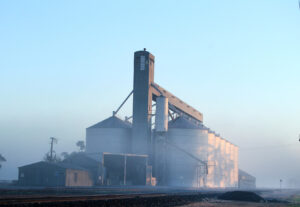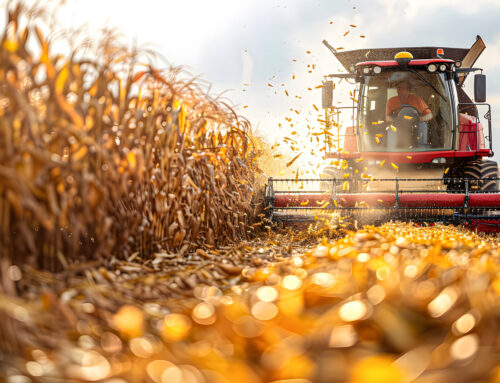
Early morning mist settles over a grain elevator complex in the Corn Belt, where winter testing of storage conditions is underway.
When temperatures drop across the Midwest and Corn Belt, grain storage behavior changes dramatically. Cold air, fluctuating humidity, and uneven bin temperatures can cause inaccurate grain moisture readings — especially if your moisture tester isn’t calibrated for winter conditions.
Accurate readings are critical to profitability. A single percentage point error can cost thousands of dollars through shrink, dockage, or reduced sale weight. Here’s what causes inaccurate readings in cold weather — and what you can do about it.
❄️ Why Cold Grain Gives Inaccurate Readings
Grain behaves differently in cold storage. Cold kernels release moisture slowly, which makes testers read lower than the true moisture level. If you test grain straight from a freezing bin, the result might show it’s “dry enough” when it’s actually not.
In addition, large temperature swings between sunny days and freezing nights create moisture migration inside bins. Warm air rises and cold grain sinks, moving moisture upward and outward. The result? Condensation forms under the bin roof or along sidewalls — creating hidden wet pockets that can quickly lead to spoilage or crusting.
Pro tip: Never rely on one sample. Pull samples from multiple depths and sides of the bin to get a complete picture of your grain’s condition.
🌡️ Best Practices for Accurate Winter Moisture Testing
-
Warm Grain Samples Before Testing
Bring cold grain samples indoors and allow them to warm up for 30–60 minutes to room temperature (60–70°F). Equalizing temperature stabilizes internal moisture and provides a far more reliable reading.
-
Test Multiple Bin Zones
Collect samples from the top, middle, and sidewall areas to identify early warning signs of moisture migration or uneven drying.
-
Inspect for Condensation or Crusting
Visual cues like moisture under bin roofs or clumped grain indicate poor airflow and imbalance.
-
Calibrate Regularly
Even a well-handled digital tester will drift slightly over time due to temperature cycles and normal use. Calibration ensures readings match true moisture content.
Corn Belt Testing provides professional calibration, repair, and service support for nearly all leading models, adjusted specifically for cold-weather accuracy.
⚙️ Why Calibration Is Non-Negotiable in Winter
Manufacturers recommend recalibrating grain moisture testers every 6–12 months, but winter is the most critical time to ensure accuracy. Cold conditions amplify even small sensor variances, which can distort readings enough to affect drying strategy, aeration control, and marketing decisions.
If your tester hasn’t been serviced since before harvest, schedule calibration now to prevent costly misreads. Corn Belt Testing’s certified technicians specialize in seasonal adjustments for the Corn Belt’s winter environments, helping you stay compliant and confident.
🌾 Upgrade to More Reliable Equipment
Modern testers designed for temperature variation deliver faster, more consistent readings. Explore the latest Grain Moisture Testers — including Dickey-John and GAC® models — engineered for both farm and commercial facility use.
📘 Trusted Resources for Grain Storage Management
Farmers looking for more in-depth guidance often rely on:
- USDA Grain Storage Handbook – official federal standards and best practices.
- Iowa State Extension: Winter Grain Storage Guide – science-backed recommendations for temperature and aeration management.
💡 Frequently Asked Questions
What temperature should grain be tested at in winter?
Allow grain to warm to room temperature (60–70°F) before testing. Cold grain usually produces artificially low readings.
How often should a moisture tester be calibrated?
Every 6–12 months. Winter calibration is especially important to counteract temperature-related drift.
Why does moisture migrate inside bins?
Warm air rises and cool air sinks, pushing moisture toward bin walls or roof areas, leading to hidden condensation and crusting.
Can inaccurate readings reduce profits?
Yes. Even a 1% moisture error can trigger shrink loss, price dockage, and load rejections — costing thousands in lost value.
📞 Protect Your Grain — Protect Your Profit
Cold weather shouldn’t compromise your grain quality or profit margin. By acclimating samples, testing multiple bin zones, watching for migration, and keeping your equipment calibrated, you’ll maintain accuracy and prevent losses.
At Corn Belt Testing, we help farmers and grain facilities across the Midwest maintain accuracy and confidence in every reading.
📞 Call Jim: 1-866-845-6249
🌐 Visit: www.cornbelttesting.com
📧 Email: jimd@cornbelttesting.com
Corn Belt Testing — Protecting Your Grain. Protecting Your Profit.






